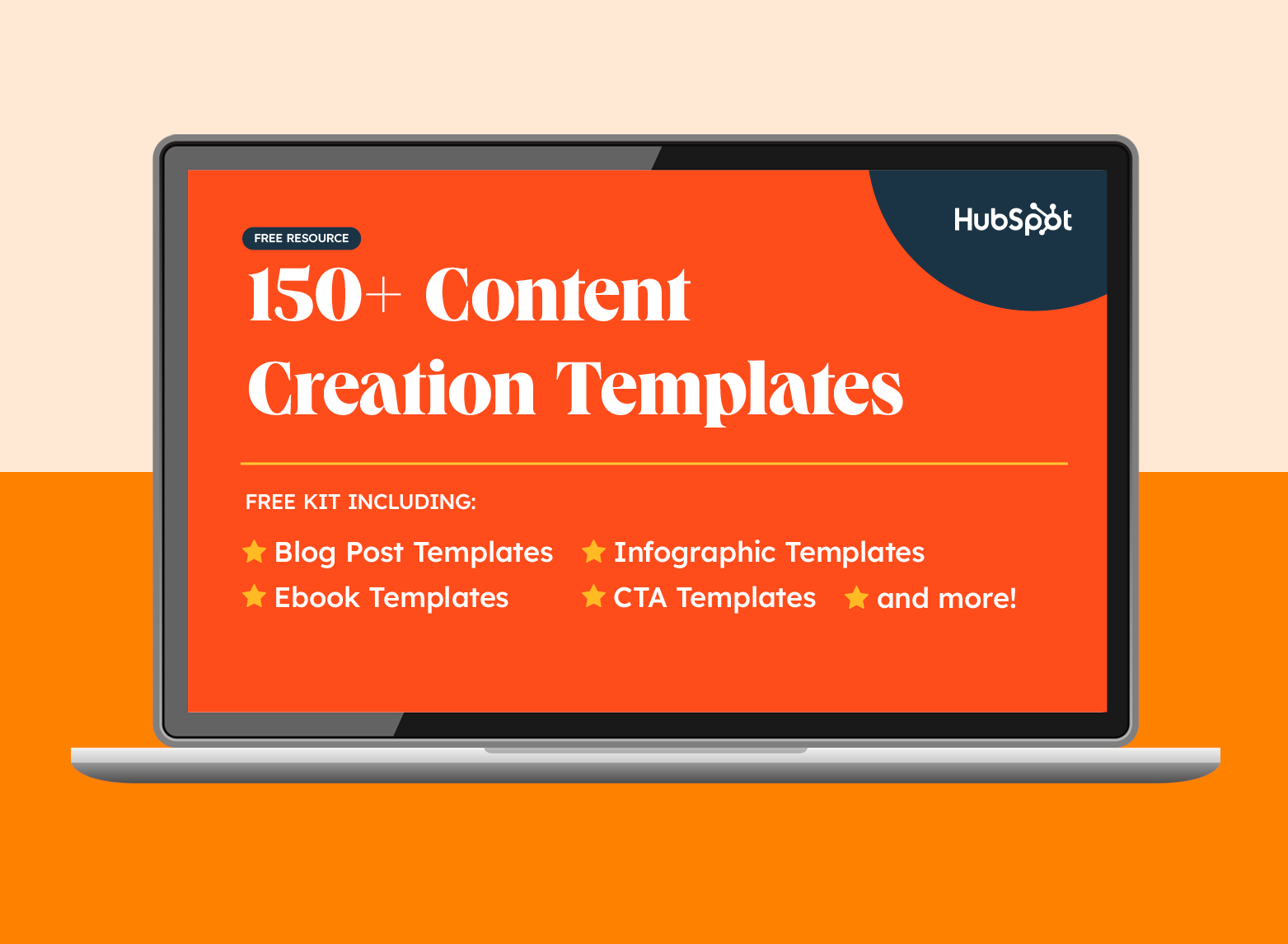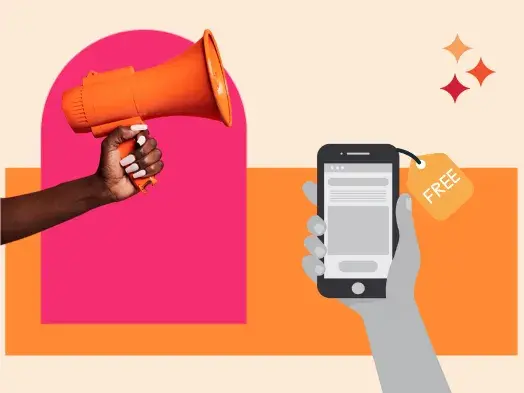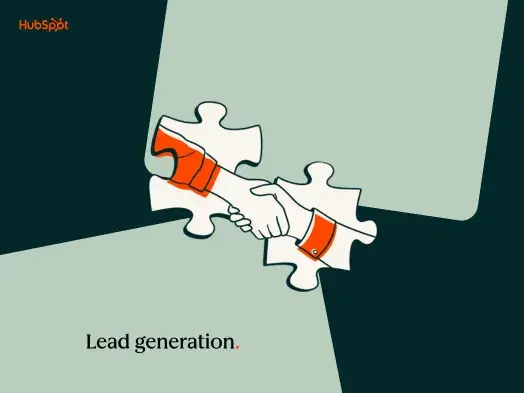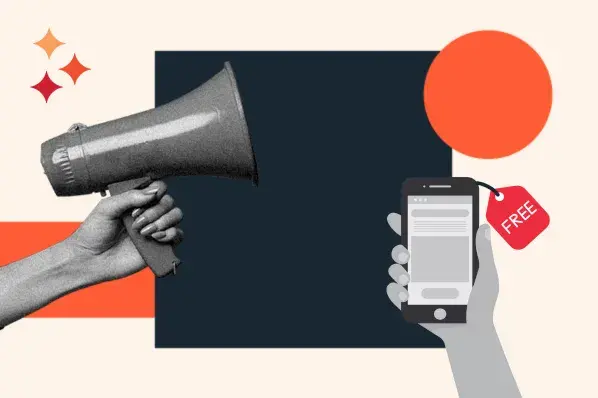Then, the plot twists:
- “I spent three weeks designing the perfect lead magnet… and got six downloads. I’m miserable.”
- “I slapped together a checklist in 15 minutes. It brought in 200 leads. Woo-hoo!”
It left me wondering whether lead magnets have to be complicated and if there are any patterns you and I can replicate. Guess what? I found them after talking to subject-matter experts. Here are 20 lead magnet examples you can replicate quickly by reusing content you already have.
Table of Contents
- What is a lead magnet?
- How to Create a Lead Magnet
- 5 Lead Magnet Examples
- 15 Additional Lead Magnet Ideas to Try
What is a lead magnet?
A lead magnet is a marketing tool that generates leads by offering a long-form resource in exchange for a prospect's contact information. Lead magnets can take the form of ebooks, whitepapers, templates, and similar downloadable assets.
Before I share lead magnet examples, let's quickly review the conversion path that turns website visitors into leads — and the role email marketing plays in this process.
- Call to action (CTA): This is the button that website visitors click to access the resource you're offering.
- Landing page: This is where your lead magnet captures information provided by the visitor. Once visitors click on the CTA, they‘re brought to a landing page where they fill out a form with their name, email address, and any other relevant information you’ve deemed important.
- Thank-you page: The visitor-turned-lead now lands on a thank-you page with information on where to access their resource and is added to your mailing list.
- Kickback email: The kickback email is your follow-up message to the lead a short time after the exchange takes place. This email marketing campaign starts a conversation with the lead to keep them engaged with your business.
Every piece of content you’ve created — blog posts, guides, videos, even internal docs — has the potential to bring in new leads. The goal is to turn what you already have into a lead-generating machine.
What is a good lead magnet?
A good lead magnet is something your ideal customer really wants. I love to say it's about hitting the right nerve.
A strong one needs to:
1. Be relevant to your audience.
Relevance beats reach every time. Early in my career, I made the mistake of going broad, creating general templates and checklists just to collect emails. And sure, I got signups … but most of them never converted. They weren’t really my people.
Now, I’d choose topics my ideal customer actually cares about – even if it means fewer but high-quality leads.
A McKinsey report backs that up: Companies using relevance-driven personalization generate 40% more revenue than those that don’t.
That’s because when your offer speaks directly to the right problem, people pay attention – and they’re way more likely to convert.
2. Provide value to your audience.
Once you know who you’re talking to, your next move is creating something valuable. Personally, I always ask: Would I trade my email for this? If the answer’s no, it’s back to the drawing board.
Don’t regurgitate what's already out there. Instead, offer something they can’t Google in 5 minutes:
- A shortcut to save time
- A framework that solves a frustrating problem
- A fresh perspective backed by your unique data or experience
For example, HubSpot recently gated a report titled The 2025 State of Marketing based on data from 1,460 marketers.

It’s packed with insights on AI adoption, channel performance, and consumer behavior shifts. Reports like these help HubSpot generate thousands of qualified leads and secure link placements on the most thought-after media outlets.
Why? Because they give people something they can’t get anywhere else – real data, real takeaways, real value.
3. Be trustworthy.
People don’t just hand over their info anymore unless they trust you.
According to Demand Gen Report’s Content Preferences Survey, 54% of buyers said they don’t trust low-quality content.
The report made it clear: only personalized, data-backed lead magnets actually drive engagement, build trust, and move buyers closer to a decision.
Moreover, nothing kills credibility faster than a lead magnet full of typos. If it looks rushed or sloppy, people assume everything else is too. That’s why I always double-check every guide before it goes out and get a second pair of eyes to give it a quick look too.
When something’s polished and professional, it sends the message: we care, and we know our stuff.
Trust is earned with facts, clarity, and respect for your reader’s time.
4. Make your audience want more.
It’s a fine line – give people enough to get them excited, but not so much that they don’t need you anymore. You’re not trying to trick them, but you’re also not here to solve everything for free.
A free tool or freemium version? Perfect example. It shows your value, gets them in the door, and if they want the full experience, they’ll need to upgrade.
In fact, product-influenced revenue is highest among SaaS companies with a self-serve freemium model, making up about 90% of total revenue.

But here’s the catch: that number drops to just 28% for companies in the bottom quartile, proving that simply offering a freemium plan isn’t enough. You need to design this strategically – give users enough to get hooked and create a good onboarding experience.
5. Be shareable content.
Your lead magnet should be crafted to be easily shared because when your audience loves it and shares it, you've just sparked a mini viral moment.
That’s why 94% of marketers repurpose content, proving nearly everyone maximizes one asset across multiple formats.

That means your lead magnet should be built to break into bite-sized, sharable pieces — snippets, visuals, social cards, or quick videos.
Here’s how to put it into action:
- Host it on a clean, standalone landing page with big, easy “Share” buttons.
- Create ready-to-post snippets — quotes, tips, stats — text or visuals that map back to the original.
- Pin or highlight your lead magnet in social profiles for easy discovery.
- Repurpose it: turn it into a carousel, a short video, or even a tweet series to multiply your reach.
This Semrush LinkedIn post is a solid example:

It takes a useful piece of content – a content strategy template – and turns it into a quick, scroll-stopping post that starts with a relatable problem, delivers value right away, and invites engagement with a swipeable walkthrough.
Obviously, it worked: the post was reposted 79 times.
When you design your lead magnet for shareability and repurposing, you’re priming your audience to become your best promoters.
How to Create a Lead Magnet
- Figure out who you're targeting and what they want.
- Create, design, and name your lead magnet.
- Build your conversion path.
- Tailor your lead magnet to buyer personas.
- Set a schedule to update regularly.
1. Figure out who you're targeting and what they want.
The goal of a lead magnet is to offer something your audience wants in exchange for their contact information.
To do this, you have to know what user persona you're targeting and what offer would entice them.
You may have one to three personas with different needs and pain points. That means one lead magnet likely won't appeal to all three personas.
Let’s say I run an influencer marketing agency. I might be targeting two types of influencers:
- Influencer #1 doesn’t fully understand how brand partnerships work and needs help building their personal brand.
- Influencer #2 is overwhelmed with admin tasks and doesn’t have time to create content.
For the first group, I’d create knowledge-based lead magnets, such as ebooks, guides, or how-to guides. For the second, I’d offer time-saving tools like templates or automation checklists.
To shape these offers, I’d check what competitors are sharing and review my own content. If my audience is more engaged with videos or asking about certain topics, that tells me exactly what kind of content they want.
2. Create, design, and name your lead magnet.
Now that you know what your offer will be, it's production time. You have to create and design your lead magnet.
If you don't have an in-house designer, you can outsource the work or use a platform like Canva. Their platform offers hundreds of templates that you can customize to build your lead magnet, everything from books and presentation slides to worksheets and reports.
AI tools are also a huge help. I often use Reve to generate on-brand images fast, and play around with Sora for more creative or video-based content. Both are fantastic.
For example, here’s the exact prompt I gave Sora when I needed a cover for my ebook:

And here’s what I got — it matched exactly what I had in mind:

Always give your lead magnet a title that’s both catchy and clear enough. Don’t overcomplicate it. If people don’t get what it’s about at first glance, they probably won’t click.
Some solid examples:
- “The Ultimate Guide to Influencer-Brand Partnerships” tells you exactly what you’re getting.
- “10 Email Templates That Actually Get Replies” is benefit-driven and easy to scan.
- “The Checklist Every New Founder Needs” is short, clear, and useful.
3. Build your conversion path.
The next step is building your conversion path, which must include your landing page, thank-you page, form, and email sequence.
Starting with your landing page, there are a few best practices to improve conversions:
- Have a dedicated landing page that doesn't include a navigation bar. This will keep users' focus on your offer and not on the other pages on your website.
- Write a clear call to action. Your CTA should be clear, short, and to the point. It should also use words that will appeal most to your audience.
- Consider eye scanning patterns. Users in Western cultures typically follow F- and Z-reading patterns, which is why most landing pages are designed with key elements placed in those zones.
- Add social proof. Adding reviews and testimonials to your landing pages adds credibility to your offer and can increase your conversion rate.
For your form, the two pieces of information you'll want to include are name and email. Everything else is optional. However, keep in mind that the more fields you include, the higher the chance a user may abandon the form.
Next up, your email sequence: Once you've acquired your lead, you can add them to a nurturing sequence that will lead them further down the funnel. This can include additional resources, such as webinars and newsletters.
4. Set up conversion tracking.
Once your lead magnet is live, track how users move through each stage so you can identify drop‑off points, optimize messaging, and boost conversions.
Here’s what you should pay attention to.
- Landing page behavior: Pageviews, scroll depth, time on page, bounce rate.
- CTA: Button clicks, click-through rates.
- Form interactions: Form views, submissions, field drop-off.
- Traffic sources: LinkedIn, email, search, etc.
- Conversion rate per step: % of users progressing from landing page – form start – form submit – thank you page.
Pro tip: Use HubSpot’s “Analyze form submissions data” guide to see page views, submission counts, and conversion rates for each form.

4. Tailor your lead magnet to buyer personas.
Once your lead magnet is ready, it’s time to get it in front of the right people.
I always start by thinking about the real problems my ideal customers are trying to solve — not what I want to say, but what they’re already searching for.
Let’s say I run a fitness business and you’re speaking to three very different personas:
- Sarah is a busy mom in her 30s trying to lose baby weight.
- Mark is a college athlete focused on building muscle.
- Barbara is a retiree working on flexibility and balance.
Now, if I write something like “10 Quick and Easy Workouts for Busy Moms,” that’s perfect for Sarah — but Mark and Barbara will scroll right past it.
The same thing goes for “5 Protein-Packed Meals for Muscle Gain.” That’s great for Mark, but not relevant for the other two. And, “Gentle Yoga Poses for Seniors?” A total miss for Sarah and Mark, but just right for Barbara.
The takeaway? When you are crafting a lead magnet, you have to design it for a single persona. That means one topic that’s specific and relevant.
Here’s my quick checklist on how to pick topics to promote a lead magnet:
- Solve a real problem. Don’t regurgitate generic advice; dig into the actual pain points your audience is dealing with right now.
- Get ultra-specific. “How to grow your business” is fine. But “5 ways plumbers can book more jobs this summer”? Way better.
- Share real proof. People love numbers. Use your own data, case studies, or client wins whenever you can.
- Make it actionable. Give people steps they can use today.
- Write a strong headline. “Double your sales in 30 days” beats “Increase your revenue.”
- Promote where it matters. Go where your audience hangs out.
- Create urgency. A time-sensitive bonus or deadline can prompt someone to download it now instead of waiting until “someday.”
To help you never run out of engaging content ideas, HubSpot has created the Free Blog Ideas Generator. Use it to generate content ideas relevant to your lead magnets. Simply mention what the lead magnet is about and enjoy content ideas that your potential customers are interested in.

5. Set a schedule to update regularly.
Depending on the type of lead magnet, experts advised me to set a reminder to update it every 6 to 12 months.
Let’s say you put out a report on 2023 data science salaries. Now that it’s 2025, it’s way overdue for a refresh. Ideally, you’d pull in updated numbers from last year — or even better, grab some early data from the first half of this year if it’s available.
If you don’t, the whole thing starts to feel stale. No one wants to download outdated content.
I also make it a point to read through any feedback. If I’ve sent out a survey or gotten comments from leads, I go through them.
One small comment or question can easily spark a new idea. Sometimes, I just update what I have. Other times, I create a completely new lead magnet that matches what people are looking for.
5 Lead Magnet Examples
1. State of Sales Report by HubSpot
What I like: The copy hits the reader’s biggest challenge – staying competitive in a noisy sales environment. It leads with a credibility hook (1,400+ sales pros), then delivers concrete reasons to care: AI adoption, data trust, team enablement, and rep retention.

A free PDF is a data-rich, research-backed guide showing what top-performing sales teams are doing differently. Topics include the impact of AI on revenue, the #1 growth tactic in 2025, and what’s causing trust issues in sales data.
This lead magnet is built for sales leaders, RevOps pros, and B2B strategists who need fresh benchmarks and smart insights to steer their next big move.
2. Her First $100K
What I like: This landing page nails relatability. It starts by calling out the reader’s exact thought process – the guilt after an impulse buy or wondering where your money went. It’s casual, sharp, and emotionally spot-on.
The tone is Tori Dunlap’s brand in a nutshell: honest, no-shame money education.

Tori Dunlap is the founder of Her First $100K, a money and career platform for women. She’s known for empowering young women to take control of their finances with clear, unfiltered advice.
This free 1-hour workshop includes tips on resisting impulse buys, saving smarter, and feeling good about where their money goes.
This is made for millennial and Gen Z women who are tired of feeling out of control with their money. The messaging avoids financial jargon and instead leans into empathy, confidence, and community. Plus, the urgency of a live countdown adds a smart layer of FOMO that encourages quick sign-ups.
3. HubSpot Website Grader
What I like: The grader helps you identify potential issues with your website and offers a solution to resolve them.
Another interactive lead magnet you can consider is a grader or calculator.
HubSpot offers a website grader, which takes seconds to scan your website and provides a score based on performance, mobile experience, SEO, and security.

After providing your email and website, you get a detailed report about your website's performance along with a corresponding course based on your results.
4. Henry Schein One
What I like: Henry Schein’s quiz hits the mark by turning a common problem into an easy, interactive experience. Instead of offering a static PDF, it pulls users into a set of questions that feel more like a consultation than a download.
You only get your personalized results after filling out the form, which makes the value exchange feel totally fair.
![]()
This assessment quiz covers things like patient acquisition, digital presence, online reviews, and engagement.
It’s built for dental practice owners and office managers who want a quick check on how their marketing’s doing without digging through a long report. The quiz lets Henry Schein qualify leads based on answers while also showing off their expertise with instant, personalized tips.
5. James Wedmore's Free Business-Building Training Series
What I like: The language is personal, casual, and packed with curiosity triggers (“step-by-step,” “brand-new offer,” “as it all unfolds”). It’s designed to feel like insider access, which makes it irresistible.

You get access to a free audio series called The Course Chronicles, where James shares his full process for creating and launching an online offer. The page also offers three more free resources tailored to different business stages.
With multiple entry points, James keeps it personal, relevant, and sharp. A smart mix of storytelling, strategy, and segmentation.
15 Additional Lead Magnet Ideas to Try
1. Ebooks
An ebook is perfect when you have a series of blog posts about a related subject. For example, if I were running an online pet store, I might pick out the following five posts from my blog to combine into an ebook:
- “The 5 Pieces of Equipment That Every Puppy Needs”
- “The Ultimate Guide To Housetraining a Puppy”
- “The First 6 Months: What You Can Expect From Your New Puppy”
- “The Puppy Nutrition Guide: What Your Dog Should and Shouldn't Eat”
- “The 7 Things You Should Never Do When Training a Puppy”
I could logically compile these posts into an ebook titled: “The Puppy Planner: Everything You Need To Know To Prepare for Your First Puppy.”
This type of ebook is effective because I'm making the lives of my website visitors easier, which should be the goal of any lead magnet.
The most successful lead magnets offer an irresistible and instant reward to your visitors, and the ebook checks off that box.
Featured Resource: 18 Free Ebook Templates
2. Guides
If you're in a well-established industry, creating original content that hasn’t already been covered can be tough. When that happens, I like to build an ultimate guide.
An ultimate guide is a curated collection of the best articles on a topic. Unlike an ebook, I don’t repurpose my own blog posts — I link to other sites.
I never copy content, though, but I link back to the original source (that’s the rule, not some personal preference, btw).
A great example here is Brian Dean’s “Link Building: The Definitive Guide.” He didn’t just list links; he grouped them, added context, and made it easy to follow.

Design also plays a role. His guide looks great, which makes it feel like a resource worth bookmarking.
And if you look on the left side of the site, you’ll see this content has been shared over 6,600 times. That just goes back to what I mentioned earlier — the importance of creating a lead magnet that’s super shareable.
3. Bonus Packs
Offering extra content that’s not in the original blog post is a great way to reward readers who opt in.
Let's go back to the post I mentioned earlier, The 5 Pieces of Equipment Every Puppy Needs. Here, I could offer a bonus PDF with some newer products that hit the market since the article was published.
A solid example is Justin Welsh’s article, My complete $10M journey (all 23 steps). At the beginning and end, he offers a downloadable bonus packed with tools, templates, and extra insights not found in the main article.

A smart move that turns casual readers into engaged subscribers, making the content way more valuable and sticky.
4. Resource Libraries
If you’ve already put together a solid blog post, think about offering a resource library or guide as a lead magnet.
A resource library is a curated set of tools, tutorials, or templates that help people get real results faster.
The first thing that comes to my mind is Ahrefs’ Academy Hub. It’s loaded with SEO tools, tutorials, and data sets that turn casual visitors into power users.

5. Checklists
Instructional blog posts are just waiting to be turned into checklists — and they couldn't be easier to create.
What I do is take my blog post and simplify it into a series of bullet points. Then I removed any points that don’t offer actionable advice. After that, I split the list into numbered steps to make the whole thing feel more doable.
Bonus points if you offer the checklist in a printable format so people can physically tick off each item on the list as they complete it. This sense of achievement is a great feeling that people will attribute back to your business.
The “Ultimate Webinar Checklist” from HubSpot is a valuable lead magnet because of how practical it is.

Hosting a webinar involves balancing a lot of different tasks coming together at the same time. This checklist informs you about everything you need to watch out for, from pre- to post-webinar.
6. Workbooks
A workbook is a simple, download-and-complete tool that helps people apply your blog post’s ideas to their own business. I like workbooks because they make people learn by doing, and that’s where you position yourself as the expert.
When creating one, carefully choose exercises that pull out info bit by bit, so by the end, the user has a complete, useful result.
Workbooks are also a great way to lead people toward your premium offers, so don’t forget to include a clear CTA at the end.
HubSpot creates practical gated workbooks to capture new leads, like this Free Sales Plan Template:

7. Case Studies
Case studies rely on specific content, but the wins they show can really push visitors to take action.
I recommend that you always get the client’s permission first. That’s non-negotiable. Once approved, gate the case study behind a form so visitors have to leave their name and email to read it.
This is a strong lead magnet because it shares real success stories and builds trust.
For instance, Belkins does this well. Their case studies highlight client challenges and the concrete results their outreach and appointment setting solutions delivered, helping turn readers into leads through authentic proof.

Featured Resource: 3 Free Case Study Templates
8. Webinars
Webinars don't have to be long, collaborative presentations with multiple colleagues or partners.
If you‘ve got a blog post that merely touches on a subject you’re an expert in, use this blog post as a springboard into a live talk hosted by you and a coworker.
If you've written an article about the latest IOS cookie restrictions, for example, convert this article into a slide presentation and present it through a live conferencing platform, using helpful visuals.
You should also provide insight that listeners wouldn't have gotten from just the blog post.
As a bonus, you can use the webinar recording as an additional offer.
Not to be totally biased, but HubSpot free webinars are one of my favorites because they break down complicated stuff in a simple way, keep me hooked, and always give me tips I can actually put to work.

9. Cheatsheets
If your blog post covers a complicated topic, it might be a good idea to offer readers a one-page sheet that they can refer back to when they need to refresh their memory. This could be a glossary of terms or just a summary of some key points.
This type of download-and-keep resource takes the pressure off readers so they don't have to memorize or implement your strategy immediately. It does compel readers to opt-in to your list, though, which is the ultimate goal.
Additionally, the compact format allows people to quickly glance at it while they are going through the editing process. It's a complementary tool for an existing process.
One example I like is Canva’s handy how-to cheatsheets.
![]()
They’ve got quick-reference guides on things like color theory, font pairing, and branding — super practical stuff you can keep open while working on your designs. I’ve used a few myself, especially when I need a creative boost or a quick reminder.
10. Guestbook
Guest blogging is one of my favorite backlink strategies, but there’s usually a catch. Most sites that accept guest posts don’t want you to republish the same article on your own blog. Totally fair, since Google tends to penalize duplicate content, and no one wants that.
What I like to do instead is turn all my guest posts into a downloadable ebook. Since it’s gated behind a lead form, there’s no issue with duplicate content, and it gives me a way to repurpose work I already put a ton of effort into.
It’s a simple way to squeeze more value out of content that would otherwise just sit out there doing SEO work for someone else.
11. Whitepapers
Have an interesting survey that your team recently ran? Or perhaps you know your audience is looking for specific information to inform their future strategy?
If so, leverage this knowledge to create downloadable reports based on your team's research.
You may have talked about these findings in a blog post or a recent webinar. Repurpose that content for a detailed report.
For example, here’s a section from HubSpot’s whitepaper on how AI is transforming GTM operations at organizations across the APAC region:

This type of content will position you as a credible resource in your industry and bring you that much closer to converting your target audience.
12. Templates
People love anything that helps them save time or skip the stress of starting from scratch, and templates do exactly that. Whether it’s emails, social media posts, spreadsheets, or design layouts, there’s always something your audience wishes they didn’t have to build themselves..
Once it’s made, a template is super low-maintenance. Set it up, gate it behind a form, and let it work for you.
Check these four brands that create amazing templates:
- Notion offers ready-to-use workspace templates for productivity, content calendars, CRM, and more.
- Canva has thousands of free and premium templates for social media, presentations, resumes, and branding.
- HubSpot shares marketing, sales, and customer service templates (like email sequences, blog outlines, and reporting spreadsheets).
- ClickUp provides workflow and project management templates that teams can use right out of the box.
Templates are easy to produce, but they deliver tons of value. And that’s what makes them such strong lead generators.
13. Email Course
Email courses are an easy, often overlooked way to launch a course without the hassle. What I like about this format is that it’s familiar, easy to set up, and way less work than building a full course.
Plus, you get more chances to engage your audience and guide them toward becoming customers, much better than a one-off ebook that might never get opened.
For example, Steve Adcock from Think Save Retire put together a 7-day email course to help folks start their own money blog. He used Kit to automate sending the emails over several days, covering topics like starting a money blog, picking a domain, and building an email list.

The platform’s simple interface and useful reporting helped him track signups and see how each email performed.
14. Access to a Private Group
As a business, community management is a key aspect in gaining brand loyalists. It can also be an effective way to generate leads. Platforms like Slack, Facebook Group, and LinkedIn allow you to do both.
For example, Digital Olympus recently launched a Digital PR channel in their Slack community, a spot where people can share expert quotes, pitch journalists, or connect about getting featured in top publications. That kind of space makes it easier to build relationships and understand what the audience really needs.

15. Behind-The-Scenes or “Secret” Insights
Although we’re accustomed to seeing behind-the-scenes videos from various companies, one of the best lead magnets I’ve ever encountered is from Buffer, a social media scheduling tool.
They regularly share detailed transparency reports showing their financials, revenue, and even team salaries. These reports give their audience a real look at how they run their business.

By sharing this kind of behind-the-scenes content, Buffer builds huge trust with their community. People feel like they’re part of something real and open.
Don’t just post — convert.
If you’ve already put in the work to create content, don’t just let it collect dust. Turn that stuff into lead magnets that pull people in. I’m talking checklists, email courses, insider tips — the kind of value that makes someone want to hand over their email.
To get started, pick what you’re best at and build from there. I’ve seen firsthand how even one smart lead magnet tied to the right blog post can turn casual readers into legit leads.
Don’t overthink it. Be useful. Be real. And make every piece of content do more than just sit there looking pretty.
Editor's note: This piece was originally published in May 2018 and has been updated for comprehensiveness.
Lead Generation








![Gated Content: What Marketers Need to Know [+ Examples]](https://53.fs1.hubspotusercontent-na1.net/hubfs/53/UNGated%20Content.png)

![What Is Demand Generation? Here’s How You Can Create Buzz for Your Offering [FAQs]](https://53.fs1.hubspotusercontent-na1.net/hubfs/53/demand-generation-1-20250321-225687.webp)


![Lead Generation Content: Top Types to Use [Data + Expert Tips]](https://53.fs1.hubspotusercontent-na1.net/hubfs/53/lead%20generation%20content.webp)